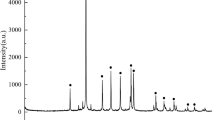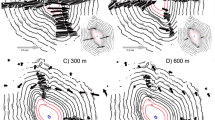Abstract
The effects of thermal curing reactivity on the phase-separated structures of acrylic copolymer/epoxy thermosetting resin composites containing various accelerator amounts were investigated to elucidate their phase separation behavior. These composites exhibited a sea-island structure, in which the island size decreased as the amount of accelerator increased. The island diameter distribution was represented as a lognormal plot. Island formation is explained by the law of proportionate effect. As observed during the last stage of phase separation via spinodal decomposition, small domains formed prior to coalescing. The effects of material composition on the phase structures and mechanical properties of acrylic copolymer/epoxy thermosetting resin composites were also examined. The morphologies varied depending on the components, and in particular, the total island area fractions and fracture surface shapes after the tensile tests differed. A small fraction of island area resulted in a lower fracture surface roughness and higher mechanical strength, indicating that in stronger composites, many epoxy components remained in the acrylic copolymer-rich sea phases. In addition, the destruction of resin composites was propagated through phase boundaries because the network formation states of the sea and island phases do not significantly differ.
Similar content being viewed by others
Log in or create a free account to read this content
Gain free access to this article, as well as selected content from this journal and more on nature.com
or
References
JEDEC Standard 22, Method A113F, “Preconditioning of plastic surface mount devices prior to reliability testing”. Accessed on October 2008
Nakamura, Y., Yamaguchi, M., Tanaka, A. & Okubo, M. Thermal shock test of integrated circuit packages sealed with epoxy moulding compounds filled with spherical silica particles. Polymer 34, 3220–3224 (1993).
Iwakura, T., Inada, T., Kader, M. A. & Inoue, T. Structure-properties of acrylic rubber/epoxy adhesive by reaction-induced phase decomposition. J. Soft Mater. 2, 13–19 (2006).
Nunes, S. P. & Inoue, T. Evidence for spinodal decomposition and nucleation and growth mechanisms during membrane formation. J. Membr. Sci. 111, 93–103 (1996).
Kishi, H., Kunimitsu, Y., Imade, J., Oshita, S., Morishita, Y. & Asada, M. Nano-phase structures and mechanical properties of epoxy/acryl triblock copolymer alloys. Polymer 52, 760–768 (2011).
Yamanaka, K, Takagi, Y. & Inoue, T. Reaction-induced phase separation in rubber-modified epoxy resins. Polymer 30, 1839–1844 (1989).
Yamanaka, K. & Inoue, T. Structure development in epoxy resin modified with poly(ether sulphone). Polymer 30, 662–667 (1989).
Ohnaga, T., Chen, W. & Inoue, T. Structure development by reaction-induced phase separation in polymer mixtures: computer simulation of the spinodal decomposition under the non-isoquench depth. Polymer 35, 3774–3781 (1994).
Shiraishi, T., Motobe, H., Ochi, M., Nakanishi, Y. & Konishi, I. Effect of network structure on thermal and mechanical properties of cured epoxide resins. Polymer 33, 2975–2980 (1992).
Shimizu, K., Wang, H., Matsuba, G., Wang, Z., Kim, H., Peng, W. & Han, C. C. Interplay of crystallization and liquid-liquid phase separation in polyolefin blends: a thermal history dependence study. Polymer 48, 4226–4234 (2007).
Rasband, W. S. & ImageJ, N. I. H. ImageJ, NIH http://imagej.nih.gov/ij/ (1997-2012).
Schneider, C. A., Rasband, W. S. & Eliceiri, K. W. NIH Image to ImageJ: 25 years of image analysis. Nat. Methods 9, 671–675 (2012).
Lee, W. I., Loos, A. C. & Spronger, G. S. Heat of reaction, degree of cure, and viscosity of Hercules 3501-6 resin. J. Compos. Mater. 16, 510–520 (1982).
Powles, J. G. & Strange, J. H. Zero time resolution nuclear magnetic resonance transient in solids. Proc. Phys. Soc. 82, 6–15 (1963).
Meiboom, S. & Gill, D. Modified spin-echo method for measuring nuclear relaxation times. Rev. Sci. Instrum. 29, 688–691 (1958).
Tanaka, H. & Nishi, T. Study of block copolymer interface by pulsed NMR. J. Chem. Phys. 82, 4326–4331 (1985).
Tanaka, H. & Nishi, T. Study of crystallization process of polymer from melt by a real-time pulsed NMR measurement. J. Chem. Phys. 85, 6197–6209 (1986).
Nakamura, Y., Nishida, Y., Honda, H., Fujii, S. & Sasaki, M. Surface analysis of silanenanolayer on silica particles using 1H pulse NMR. J. Adhesion Sci. Technol. 25, 2703–2716 (2011).
Landau, L. D. & Lifshitz, E. M. Theory of Elasticity: Course of Theoretical Physics, Vol. 7 (Pergamon, New York, NY, USA, 1970)
Nagai, S. & Fujinami, S. Viscoelastic properties of worm-like micelle of aluminum tristearylate/decahydronaphthalene. Nihon Reoroji Gakkaishi 36, 99–106 (2008).
Colbeck, S. C. Theory of particle coarsening with a log-normal distribution. Acta Metal 35, 1583–1588 (1987).
Author information
Authors and Affiliations
Corresponding author
Ethics declarations
Competing interests
The authors declare no conflict of interest.
Rights and permissions
About this article
Cite this article
Ichikawa, I., Sugizaki, T., Akasaka, S. et al. Quantitative analysis of the phase-separated structure and mechanical properties of acrylic copolymer/epoxy thermosetting resin composites. Polym J 47, 779–788 (2015). https://doi.org/10.1038/pj.2015.68
Received:
Revised:
Accepted:
Published:
Issue date:
DOI: https://doi.org/10.1038/pj.2015.68
This article is cited by
-
The effect of Cu nanoparticle adding on to epoxy-based adhesive and adhesion properties
Scientific Reports (2020)
-
Curing Kinetics and the Properties of KH560-SiO2/Polyethersulfone/Bismaleimide-Phenolic Epoxy Resin Composite
Journal of Inorganic and Organometallic Polymers and Materials (2020)



